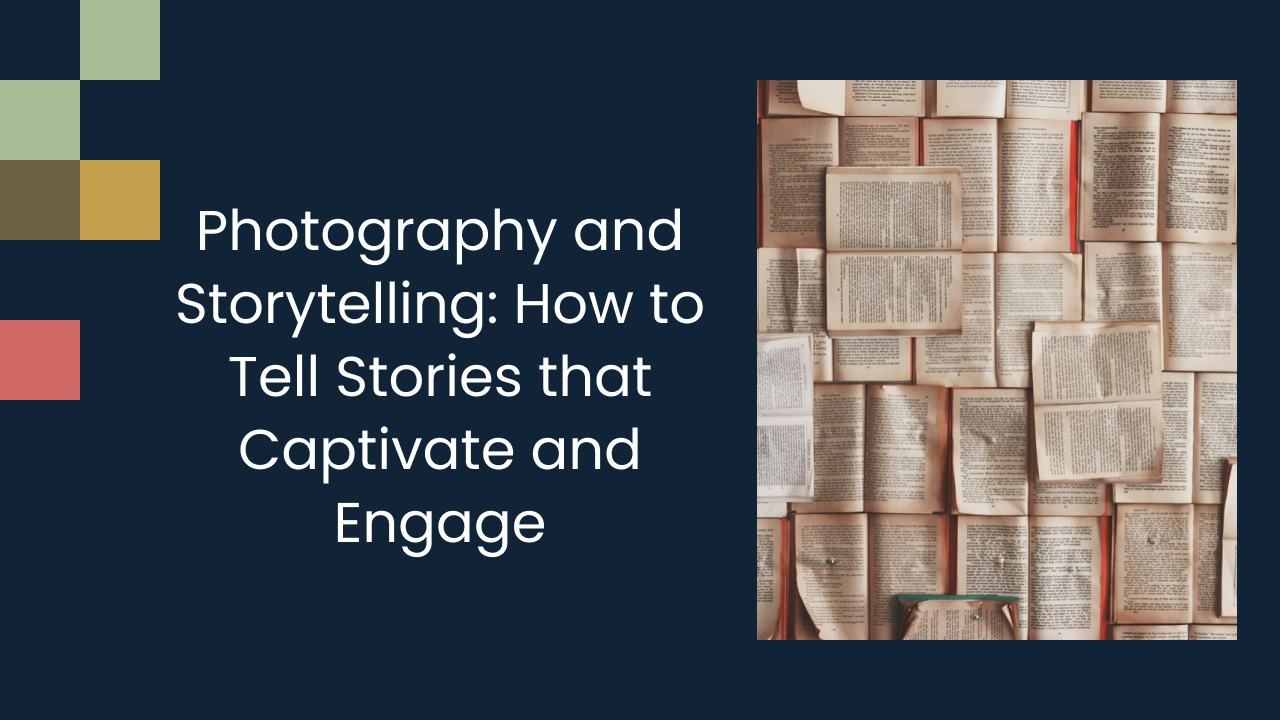Photography and Storytelling: How to Tell Stories that Captivate and Engage
In today's digital age, where visual content dominates our screens, photography has become an incredibly powerful tool for storytelling. Whether it's on social media, in advertising, or in photojournalism, photographers have the ability to capture a moment, evoke emotions, and convey narratives through their images. Understanding the connection between photography and storytelling is crucial for photographers who want to create captivating and engaging visual stories.
Understanding the Connection Between Photography and Storytelling
Photography is often referred to as the art of visual storytelling , and for good reason. A photograph has the unique ability to freeze a moment in time and convey an entire story within a single frame. It allows viewers to connect with the subject, experience the emotions captured, and ultimately, be transported into the narrative. By understanding the principles of storytelling, photographers can enhance their ability to communicate through their images.
The Art of Visual Storytelling
Visual storytelling is the art of using images to convey a narrative or message. It goes beyond simply capturing a beautiful scene; it involves composing and arranging elements in a way that engages and captivates the viewer. Just like in traditional storytelling, visual storytelling requires a clear beginning, middle, and end. It should have a central theme or message that ties the images together, creating a cohesive and meaningful story.
The Role of Photography in Narratives
Photography plays a crucial role in narratives, as it has the power to ignite the imagination and transport viewers into different worlds. Whether it's a single photograph or a series of images, photography can evoke emotions, provoke thought, and ultimately, leave a lasting impression on the viewer. It adds depth and perspective to stories, enabling viewers to connect with the subject and experience the narrative on a more personal level.
Let's delve deeper into the art of visual storytelling. One of the key elements in creating a compelling visual narrative is composition. The way elements are arranged within the frame can greatly impact the story being told. For example, a photographer may choose to use the rule of thirds, placing the main subject off-center to create a sense of balance and intrigue. This technique can draw the viewer's attention to specific details or create a sense of movement within the image.
Another important aspect of visual storytelling is the use of light and shadow. The way light falls on a subject can evoke different emotions and set the tone for the narrative. Soft, diffused light can create a sense of tranquility or intimacy, while harsh, dramatic lighting can convey tension or mystery. By understanding how to manipulate light, photographers can enhance the mood and atmosphere of their images, further immersing the viewer in the story being told.
Furthermore, visual storytelling extends beyond the individual photograph. A series of images can be used to create a narrative arc, much like chapters in a book. Each image builds upon the previous one, gradually revealing more about the subject or story. This progression can create anticipation and engagement, as viewers become invested in the unfolding narrative. Whether it's a photo essay or a photo book, the sequencing of images is crucial in guiding the viewer through the story and creating a meaningful visual experience.
Essential Elements of Storytelling in Photography
Effective storytelling in photography requires a combination of technical skills and creative vision. By mastering the essential elements of storytelling, photographers can create images that not only capture attention but also resonate with viewers on a deeper level.
When it comes to composition and framing, every element within the frame plays a crucial role in visual storytelling. It's not just about capturing a subject, but about arranging the elements in a way that conveys a sense of balance and guides the viewer's eye. The placement of subjects, the use of leading lines, and the adherence to the rule of thirds are all techniques that photographers employ to create visually compelling images. By carefully considering these elements, photographers can draw viewers into the story, allowing them to explore the narrative within the frame.
However, composition is just one piece of the puzzle. Lighting also plays a significant role in storytelling through photography. The manipulation of light can set the mood and atmosphere of a photograph, evoking different emotions within the viewer. The warm glow of golden hour can create a sense of nostalgia and tranquility, while the dramatic shadows of low-key lighting can add a touch of mystery and intrigue. Even the soft and diffused light of a cloudy day can lend a dreamy and ethereal quality to an image. By carefully choosing and manipulating lighting, photographers can enhance the storytelling aspect of their images, adding depth and dimension to the narrative.
Timing and moment are also essential elements in capturing a compelling story through photography. The ability to anticipate and capture a decisive moment can make all the difference in creating an image that resonates with viewers. It's about being in the right place at the right time, ready to capture that fleeting expression, that split-second action, or that perfect interaction. Understanding the subject and having patience are key when it comes to capturing those captivating moments that transport viewers into the heart of the story. These moments not only add depth and emotion to a photograph but also allow viewers to experience the story as if they were present at that very moment.
So, as photographers strive to tell stories through their images, they must consider the essential elements of composition and framing, lighting and mood, as well as timing and moment. By mastering these elements, photographers can create images that not only capture attention but also leave a lasting impression, inviting viewers to delve into the narrative and connect with the story on a deeper level.
Techniques to Enhance Storytelling Through Photography
In addition to the essential elements of storytelling, there are other techniques that photographers can utilize to enhance the narrative quality of their images.
When it comes to storytelling through photography, colors play a vital role in conveying emotions and setting the mood. Understanding the psychology behind colors allows photographers to strategically incorporate certain hues to evoke specific feelings. For instance, warm colors like red and orange can convey passion and energy, perfect for capturing intense moments or showcasing vibrant personalities. On the other hand, cool colors like blue and green can evoke a sense of calmness or melancholy, ideal for portraying serene landscapes or introspective moments.
Another technique that can add depth and visual interest to photographs is perspective. By experimenting with different angles, vantage points, and focal lengths, photographers can create unique perspectives that transform a simple scene into a powerful visual story. For example, shooting from a low angle can make the subject appear larger than life, emphasizing their importance or dominance in the narrative. Conversely, shooting from a high angle can create a sense of vulnerability or insignificance, highlighting the subject's vulnerability or the vastness of their surroundings.
Depth of field is yet another powerful tool that photographers can use to enhance storytelling. By deliberately choosing a shallow or deep depth of field, photographers can direct the viewer's attention to specific subjects or elements within the photograph. A shallow depth of field can be employed to isolate a subject from its surroundings, creating a sense of focus and intimacy. This technique is particularly effective when capturing portraits or highlighting a specific detail that holds significance in the story. On the other hand, a deep depth of field can be used to establish a sense of context and scale, allowing the viewer to take in the entire scene and understand the broader story being told.
By incorporating these techniques into their photography, storytellers can elevate their images and create a more immersive experience for the viewer. Whether it's through the strategic use of colors, experimenting with perspective, or playing with depth of field, these techniques offer endless possibilities for photographers to enhance the narrative quality of their work.
Creating a Captivating Photo Story
Once photographers have a solid understanding of the connection between photography and storytelling, as well as the essential elements and techniques, they can apply this knowledge to create captivating photo stories.
Planning Your Photo Story
A compelling photo story starts with planning. Before picking up the camera, photographers should have a clear concept or idea of what they want to convey. Having a pre-determined theme, subject, or narrative structure can help guide the creative process and ensure a cohesive and engaging story. Research and preparation are key to capturing the right moments and creating a thought-provoking sequence of images.
Shooting Techniques for Engaging Stories
When shooting for a photo story, photographers should focus on capturing a variety of shots that collectively convey the narrative. This can include wide-angle shots to establish the setting, close-ups to capture emotions, and detail shots to add depth and context. By employing a mix of different techniques, photographers can create a visual rhythm that keeps viewers engaged and intrigued.
Editing for Impact and Consistency
The editing process is just as important as shooting when it comes to creating a captivating photo story. Selecting the strongest images and arranging them in a logical and compelling sequence can significantly enhance the impact of the story. Paying attention to color grading, tonal consistency, and overall visual coherence can ensure that the story is presented in a cohesive and visually appealing manner.
Photography and storytelling are intertwined in a way that allows photographers to capture and convey narratives through their images. By understanding the connection between the two and mastering the essential elements and techniques, photographers can create visual stories that captivate and engage viewers. Whether it's through composition, lighting, timing, or post-processing, every decision made in the creation process contributes to the overall impact and effectiveness of a photo story. So, grab your camera, unleash your creativity, and start telling stories that leave a lasting impression.
More from Pixifi











